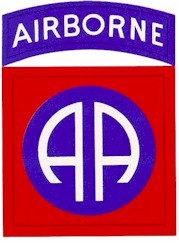|

Enlisted in the US Army from December 6, 1950 at Fort Williams, Maine until December
5, 1953. Served as a combat engineer with the 82nd Airborne Division. He was a member of the 127 Airborne Eng. Battalion,
Company C at Ft Campbell, KY.
Infantry School, April 3,
1951 - May 4, 1951Fort Benning, Georgia
6th Armored Division, February 27, 1952 - April 4, 1952: Demolition
Specialist, Fort Leonard Wood, Missouri
Engineer School, August 21, 1952 - November 21, 1952 Combat Construction
Foreman
Enlisted in the US Air Force on January 10, 1955 until January 5, 1966 as a munitions loader with the 509th Bomb Wing at Pease AFB, NH. The 509th Bombardment Wing moved to Pease
AFB, NH, in August 1958.Although the B-47s were scheduled for retirement along with the 509th in the early 1960s, SAC kept the 509th alive and equipped the wing with B-52 Stratofortress bombers and KC-135 tankers. It received its first B-52s and KC-135s in March 1966. During this
period the wing's B-52s deployed to Guam and flew Arc Light combat missions over Southeast Asia. In April 1968 and April 1969, the wing began six-month deployments to the
Western Pacific.
January 16, 1955: 564th
Motor Vehicle Squadron, Otis AFB, Massachusetts
May 21, 1955: 64th SUPRON, Otis AFB, Massachusetts as a Munitions
Specialist (46150)
|
|
Pease Air Force Base started its
long history as a 300 acre municipal airport in the 1930s. With the onset
of World War II, the U.S. Navy used an airport at the current base
location. The U.S. Air Force assumed control in 1951, when the
installation was selected for development as a Strategic Air Command (SAC)
base. Purchase of additional land needed for expansion of the base started
in 1952 and was completed in 1956. Ground breaking for the new SAC
facilities took place in 1954, and the first B-47 bombers arrived in 1956.
Portsmouth Air Force Base formally opened on June 30, 1956. In 1957, the
Air Force renamed the base Pease Air Force Base in honor of New Hampshire
native Captain Harl Pease, Jr. who posthumously earned the Congressional
Medal of Honor for heroism during World War II.
The mission of the base was to
maintain a combat-ready force capable of long-range bombardment
operations. During its history, Pease AFB has been the home of the 100th
Bombardment Wing and the 509th Bombardment Wing, whose mission is to
develop and maintain operational capacity to permit the conduct of
strategic warfare in the event of war. From 1956 until its closure in
1991, Pease Air Force Base maintained a combat-ready force for long range
bombardment operations. B-47, KC-97, B-52, KC-135 A/E/R, C-130, and FB-111
aircraft were based at Pease at varying times.
Historical information:
On January 1, 1956, the 100th Bomb
Wing (BW) was activated at Portsmouth AFB under the command of Col. James
W. Chapman, Jr. This establishment had the distinction of being the
thirty-third and last B-47 wing to activate, and was comprised of the
349th, 350th, and 351st Bomb Squadrons (BS), of 15 aircraft each. The base
was far from complete physically, but this did not slow organizational
expansion. The 100th Air Refueling Squadron (ARS), which operated 18
Boeing KC-97 tankers, was assigned to the 100th BW on August 15, 1956. |